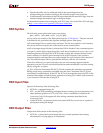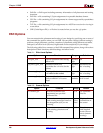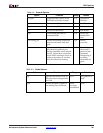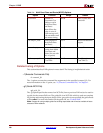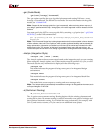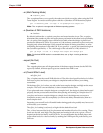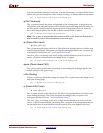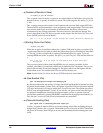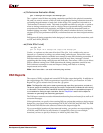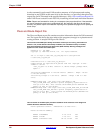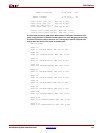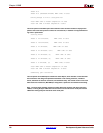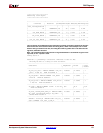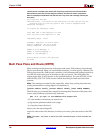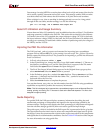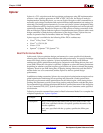
Development System Reference Guide www.xilinx.com 173
PAR Reports
R
–x (Performance Evaluation Mode)
par –x design.ncd output.ncd design.pcf
The -x option is used if there are timing constraints specified in the physical constraints
file, and you want to execute a PAR run with tool-generated timing constraints instead to
evaluating the performance of each clock in the design. This operation is referred to as
"Performance Evaluation" mode. This mode is entered into either by using the -x option or
when no timing constraints are used in a design.The tool-generated timing constraints
constrain each internal clock separately and tighten/loosen the constraints based on
feedback during execution. The PAR effort level controls whether the focus is on fastest
run time (STD), best performance (HIGH) or a balance between run time and performance
(MED).
PAR ignores all timing constraints in the design.pcf, and uses all physical constraints, such
as LOC and AREA_RANGE.
–xe (Extra Effort Level)
–xe effort_level
par –ol high –xe n design.ncd output.ncd design.pcf
Use the –xe option to set the extra effort level. The effort_level variable can be set to n
(normal) or c (continue) working even when timing cannot be met. Extra effort n uses
additional runtime intensive methods in an attempt to meet difficult timing constraints. If
PAR determines that the timing constraints cannot be met, then a message is issued
explaining that the timing cannot be met and PAR exits. Extra effort c allows you to direct
PAR to continue routing even if PAR determines the timing constraints cannot be met.
PAR continues to attempt to route and improve timing until little or no timing
improvement can be made.
Note:
Use of extra effort c can result in extremely long runtimes.
PA R Re po r ts
The output of PAR is a placed and routed NCD file (the output design file). In addition to
the output design file, a PAR run generates a report file with a .par extension. A Guide
Report File (.grf) is created when you use the –gf option.
Note:
The ReportGen utility can be used to generate pad report files (.pad, pad.txt, and pad.csv).
The pinout .pad file is intended for parsing by user scripts. The pad.txt file is intended for user viewing
in a text editor. The pad.csv file is intended for directed opening inside of a spreadsheet program. It
is not intended for viewing through a text editor. See the “ReportGen” section of this chapter for
information on generating and customizing pad reports.
The PAR report contains execution information about the place and route job as well as all
constraint messages.
If the options that you specify when running PAR are options that produce a single output
design file, your output is the output design (NCD) file, a PAR file, and PAD files. The PAR
file and the PAD files have the same root name as the output design file.
If you run multiple iterations of placement and routing, you produce an output design file,
a PAR file, and PAD files for each iteration. Consequently, when you run multiple
iterations you have to specify a directory in which to place these files.



